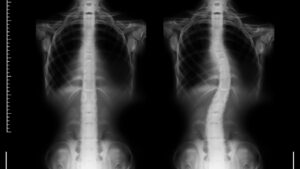Chiropractic care is a popular healthcare approach that has been practiced since 1985and is effective for many health conditions. The spine has always had a significant role in the understanding and achievement of optimal overall health; in fact, different types of “spine specialists” can be seen throughout history starting thousands of years ago in the Great Greek civilization, specifically with Socrates, who stated: “If you would seek health, look first to the spine”. The main tool that is used by chiropractors is the Chiropractic Adjustment.
What are chiropractic adjustments?
The Chiropractic adjustment performed by a chiropractor consists in applying a certain amount of force in a specific direction to restore proper joint movement and in some cases proper nerve health. Typically done with their hands, some adjustment procedures might call for the need for a small instrument called the activator or chiropractic table.
During a chiropractic adjustment, a low amplitude high velocity controlled thrust, or force is applied to the stuck or misaligned vertebra to decrease the associated pain or nerve irritation or to improve joint alignment or spinal motion.
How do chiropractic adjustments work?
A chiropractic adjustment works by applying a low amplitude, high-velocity thrust or force to the stuck or misaligned vertebra or spinal joint. By doing so, it restores spinal function and motion to the restricted joint, decreasing nerve irritation and localized inflammation and reducing the associated local muscle pain and spasm.
A popping or joint cracking sound can be heard when chiropractic adjustments are performed. The patient will often feel an immediate sense of relief and an instant improvement in spinal movements and overall mobility in the adjusted area.
How do chiropractors know where to adjust?
There are several techniques or approaches to chiropractic adjustments. Some of the more common ones are Chiropractic Biophysics, Activator, Thompson, Diversified, and Gonstead. Depending on the patient’s needs, the chiropractor will employ a variety of techniques to determine the area needed to be adjusted.
Additionally, the chiropractor may also conduct diagnostic tests, such as advanced imaging tests like MRIs and x-rays, gait studies, leg length analysis and measurement, range of motion, posture analysis, or palpation to enable them to understand the spinal condition better.
Do chiropractors actually adjust anything?
Chiropractic adjustments are not just limited to spinal joints but also appropriate for virtually any joint of our bodies. The term “adjustment” refers to the altering or moving of something slightly to achieve the desired goal. In fact, chiropractic adjustments have been proven by fluoroscopy and x-ray to demonstrate real-time results in the adjusted area.
How do I keep my chiropractic adjustments last?
Your body might initially not be used to its newly aligned movement patterns and posture after receiving chiropractic adjustments. It will take time to develop new, healthy movement and postural habits, especially after many years of poor muscle adaptation and postural patterns.
During the initial stages of chiropractic adjustments, the body is transitioning from the old to the new alignment or balance. Hence, the nervous system and spinal muscles might not be used to the new postural habits and may try to adjust back to their old position.
To ensure that your chiropractic adjustments stay in place, patients are usually recommended to walk after every chiropractic adjustment for up to ten minutes in order to reinforce new movement habits and patterns. Also, it is vital that you be intentional in observing your postures and movement patterns in your day-to-day activities.
Who will benefit from chiropractic adjustments?
Chiropractic adjustments have been proven in several research studies to benefit patients needing to go through headaches, bad posture, chronic pain, disc herniations, arthritis, sciatica, neck pain, and lower back pain treatments.
Chiropractic adjustments benefit such patients as they help to reduce pain and inflammation, minimise muscle and joint injuries, and improve flexibility, movement, and posture.
Conclusion
Chiropractic adjustments are some of the most effective methodologies for overall neuro-musculoskeletal issues. Using specific adjusting techniques to reach the desired spinal alignment to help reduce pressure on a particular soft tissue or nerve, they are able to help you achieve healthy movement habits, relieve pain, and boost overall function.
Healing Hands Chiropractic aims to help you achieve a pain-free lifestyle with our extensive range of chiropractic care and adjustments. Visit us at https://healinghands.com.sg/ to make an appointment with us today!



